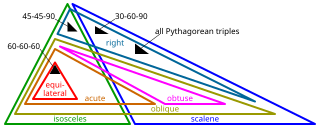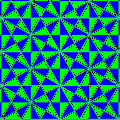Special right triangle
From Wikipedia, the free encyclopedia
"90-45-45 triangle" redirects here. For the drawing tool, see 90-45-45 set square.
"30-60-90 triangle" redirects here. For the drawing tool, see 30-60-90 set square.

Position of some special triangles in an Euler diagram of types of triangles, using the definition that isosceles triangles have at least two equal sides, i.e. equilateral triangles are isosceles.
Contents
[hide]Angle-based[edit]

Special angle-based triangles inscribed in a unit circle are handy for visualizing and remembering trigonometric functions of multiples of 30 and 45 degrees.
The side lengths are generally deduced from the basis of the unit circle or other geometric methods. This approach may be used to rapidly reproduce the values of trigonometric functions for the angles 30°, 45°, and 60°.
Special triangles are used to aid in calculating common trigonometric functions, as below:
| degrees | radians | gons | turns | sin | cos | tan | cotan |
|---|---|---|---|---|---|---|---|
| 0° | 0 | 0g | 0 | √0/2 = 0 | √4/2 = 1 | 0 | undefined |
| 30° | π/6 | 33 1/3g | 1/12 | √1/2 = 1/2 | √3/2 | 1/√3 | √3 |
| 45° | π/4 | 50g | 1/8 | √2/2 = 1/√2 | √2/2 = 1/√2 | 1 | 1 |
| 60° | π/3 | 66 2/3g | 1/6 | √3/2 | √1/2 = 1/2 | √3 | 1/√3 |
| 90° | π/2 | 100g | 1/4 | √4/2 = 1 | √0/2 = 0 | undefined | 0 |
45°–45°–90° triangle[edit]
In plane geometry, constructing the diagonal of a square results in a triangle whose three angles are in the ratio 1 : 1 : 2, adding up to 180° or π radians. Hence, the angles respectively measure 45° (π/4), 45° (π/4), and 90° (π/2). The sides in this triangle are in the ratio 1 : 1 : √2, which follows immediately from the Pythagorean theorem.Of all right triangles, the 45°–45°–90° degree triangle has the smallest ratio of the hypotenuse to the sum of the legs, namely √2/2.[1]:p.282,p.358
Of all right triangles, the 45°–45°–90° degree triangle has the greatest ratio of the altitude from the hypotenuse to the sum of the legs, namely √2/4.[1]:p.282
Triangles with these angles are the only possible right triangles that are also isosceles triangles in Euclidean geometry. However, in spherical geometry and hyperbolic geometry, there are infinitely many different shapes of right isosceles triangles.
30°–60°–90° triangle[edit]
This is a triangle whose three angles are in the ratio 1 : 2 : 3 and respectively measure 30° (π/6), 60° (π/3), and 90° (π/2). The sides are in the ratio 1 : √3 : 2.The proof of this fact is clear using trigonometry. The geometric proof is:
- Draw an equilateral triangle ABC with side length 2 and with point D as the midpoint of segment BC. Draw an altitude line from A to D. Then ABD is a 30°–60°–90° triangle with hypotenuse of length 2, and base BD of length 1.
- The fact that the remaining leg AD has length √3 follows immediately from the Pythagorean theorem.
Side-based[edit]
Right triangles whose sides are of integer lengths, with the sides collectively known as Pythagorean triples, possess angles that cannot all be rational numbers of degrees.[2] (This follows from Niven's theorem.) They are most useful in that they may be easily remembered and any multiple of the sides produces the same relationship. Using Euclid's formula for generating Pythagorean triples, the sides must be in the ratio- m2 − n2 : 2mn : m2 + n2
Common Pythagorean triples[edit]
Main article: Pythagorean triple
There are several Pythagorean triples which are well-known, including those with sides in the ratios:3: 4 :5 5: 12 :13 8: 15 :17 7: 24 :25 9: 40 :41
The possible use of the 3 : 4 : 5 triangle in Ancient Egypt, with the supposed use of a knotted rope to lay out such a triangle, and the question whether Pythagoras theorem was known at that time, has been much debated.[3] It was first conjectured by the historian Moritz Cantor in 1882.[3] It is known that right angles were laid out accurately in Ancient Egypt; that their surveyors did use ropes for measurement;[3] that Plutarch recorded in Isis and Osiris (around 100 AD) that the Egyptians admired the 3 : 4 : 5 triangle;[3] and that the Berlin Papyrus 6619 from the Middle Kingdom of Egypt (before 1700 BC) stated that "the area of a square of 100 is equal to that of two smaller squares. The side of one is ½ + ¼ the side of the other."[4] The historian of mathematics Roger L. Cooke observes that "It is hard to imagine anyone being interested in such conditions without knowing the Pythagorean theorem."[3] Against this, Cooke notes that no Egyptian text before 300 BC actually mentions the use of the theorem to find the length of a triangle's sides, and that there are simpler ways to construct a right angle. Cooke concludes that Cantor's conjecture remains uncertain: he guesses that the Ancient Egyptians probably did know the Pythagorean theorem, but that "there is no evidence that they used it to construct right angles".[3]




No comments:
Post a Comment